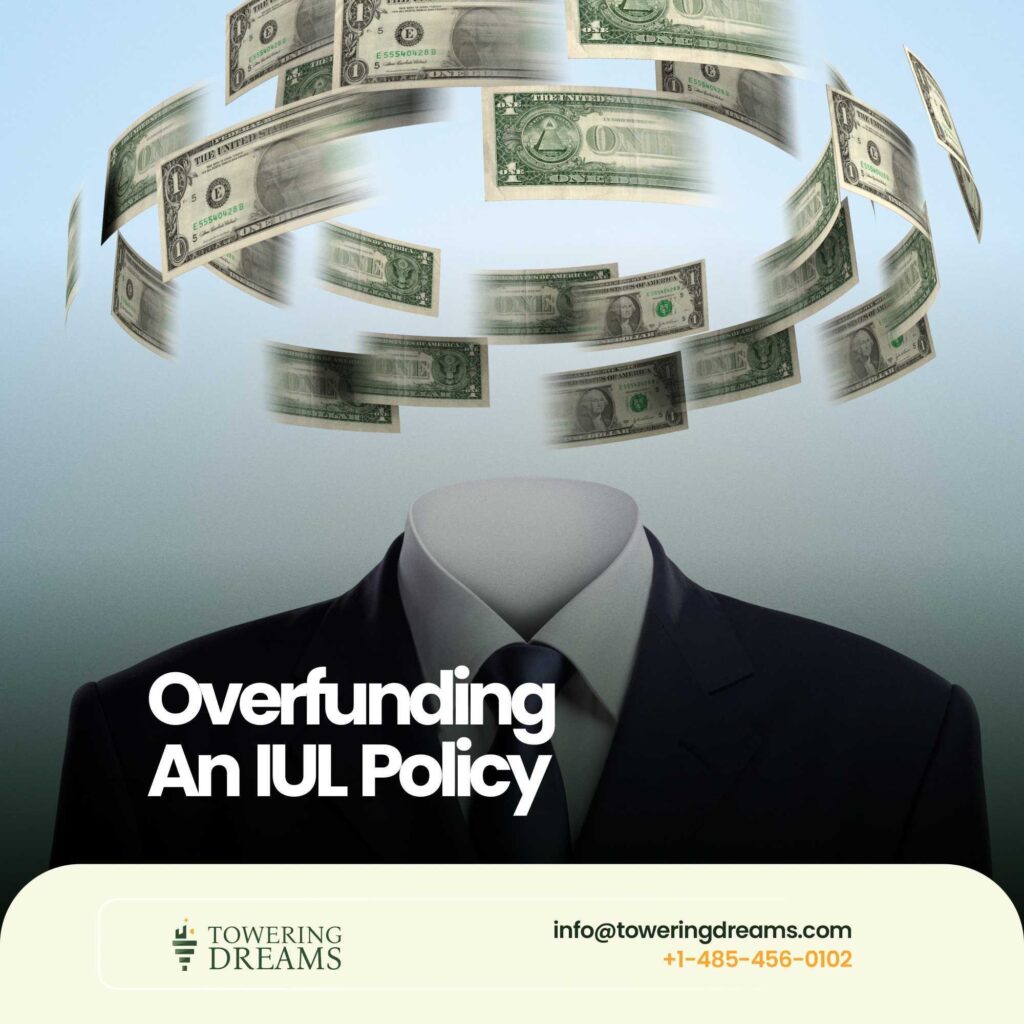
If you’ve been exploring Indexed Universal Life (IUL) insurance, you’ve probably heard the term “overfunding” thrown around. It sounds counterintuitive, right? Why would you want to put more money into an insurance policy than required?
Here’s the thing: overfunding an IUL policy is actually a strategic move that can transform your policy from simple life insurance into a powerful financial tool. When done correctly, it allows you to build significant cash value that grows tax-deferred, can be accessed tax-free, and provides flexibility that traditional retirement accounts don’t offer.
But—and this is important—overfunding isn’t right for everyone, and it comes with rules, limitations, and potential pitfalls you need to understand before diving in. The IRS has specific regulations about how much you can overfund before your policy loses its favorable tax treatment, and insurance companies have their own guidelines about maximum premium payments.
Whether you’re considering an IUL for retirement planning, wealth accumulation, or tax diversification, understanding overfunding is crucial. Let’s break down what it means, how it works, why people do it, and what you need to watch out for.
Summary
Overfunding an IUL policy means paying premiums beyond the minimum required to keep the policy in force, maximizing cash value accumulation while maintaining the policy’s tax-advantaged status. This strategy works within IRS limits called the Modified Endowment Contract (MEC) test, which determines how much you can contribute without losing tax benefits. The primary advantages include accelerated cash value growth, tax-deferred accumulation, potential tax-free loans for retirement income, and greater policy flexibility. However, overfunding requires careful planning to avoid MEC violations, understanding of fees and charges, sufficient income to make large contributions, and a long-term commitment to the strategy. When properly structured, an overfunded IUL can serve as a supplemental retirement vehicle, emergency fund, and estate planning tool, but it’s not suitable for everyone and should be evaluated within your broader financial plan.
What Does Overfunding Actually Mean?

Let’s start with the basics. Every IUL policy has a minimum premium requirement—the amount you need to pay to keep the death benefit in force. Overfunding means deliberately paying more than this minimum to rapidly build cash value.
Think of it like a 401(k) where you contribute more than your employer match. Sure, you only “need” to contribute enough to get the match, but contributing more accelerates your savings. With an IUL, you only need to pay enough to cover insurance costs and keep the policy active, but paying more builds cash value faster.
The cash value in an IUL grows based on the performance of a stock market index (like the S&P 500) with downside protection and upside caps. When you overfund, you’re putting more money into this growth engine, allowing it to compound more aggressively over time.
However, there’s a legal ceiling to overfunding. The IRS sets limits through something called the Modified Endowment Contract (MEC) test. If you exceed these limits, your policy becomes a MEC, losing key tax advantages. We’ll dive deeper into this shortly, but the key point here is that overfunding has boundaries—you’re maximizing contributions within allowed limits, not just dumping unlimited money into the policy.
Insurance companies also set their own maximum premium limits based on the death benefit and your age. You can’t just write a million-dollar check into a $500,000 policy. The relationship between death benefit and premium is regulated to maintain the policy’s status as life insurance rather than an investment vehicle.
The MEC Test and Why It Matters

The Modified Endowment Contract test is the most critical concept to understand when overfunding an IUL. It’s the line you cannot cross without serious tax consequences.
Congress created the MEC rules in 1988 because people were using life insurance primarily as tax shelters rather than insurance. The MEC test ensures that policies maintain a certain ratio of death benefit to premium, keeping them true to their insurance purpose.
Here’s how it works: The IRS calculates the maximum amount you can pay into your policy during the first seven years (called the “7-pay test”) based on your death benefit and age. If you exceed this limit, your policy becomes a MEC immediately and permanently.
Why does this matter? A non-MEC policy allows you to take tax-free loans against cash value. A MEC policy treats withdrawals and loans as taxable income first (LIFO—last in, first out), and if you’re under 59½, adds a 10% early withdrawal penalty. You lose the primary tax advantage that makes overfunding attractive in the first place.
To overfund properly, you need to work with an agent or financial advisor who understands these calculations. They’ll structure your policy to maximize premiums while staying safely under the MEC limit. This often means choosing a higher death benefit than you might otherwise need, creating more “room” for premium dollars.
The MEC test recalculates if you make certain policy changes, like increasing the death benefit or adding riders. This means you can’t just set it and forget it—ongoing monitoring ensures you maintain compliance.
Most people who overfund aim to pay right up to the MEC limit without crossing it, maximizing cash value accumulation while preserving tax benefits. It’s a delicate balance that requires expertise to navigate correctly.
Benefits of Overfunding an IUL Policy

When done correctly, overfunding offers several compelling advantages that make it attractive for certain financial situations.
Accelerated cash value growth is the most obvious benefit. More premium dollars mean more money working for you in the index-linked accounts. Over decades, this compounding can create substantial cash value that dwarfs what a minimally funded policy would generate.
Tax-deferred growth is huge. Unlike taxable investment accounts where you pay taxes annually on dividends, interest, and capital gains, your IUL cash value grows without current taxation. This allows your money to compound more efficiently, especially valuable for high-income earners in elevated tax brackets.
Tax-free access to cash value through policy loans provides incredible flexibility. When structured properly, you can borrow against your cash value without triggering taxable income. This makes overfunded IULs attractive as supplemental retirement income sources—you can access funds without increasing your taxable income or affecting Social Security taxation thresholds.
Downside protection sets IULs apart from direct market investing. Your cash value typically has a 0% floor, meaning market crashes don’t directly reduce your account value. While there are caps on gains, the protection during down markets can be psychologically and financially valuable, especially as you approach retirement.
Another advantage is that in this scenario, there is no contribution limit like in the case of 401(k)s or IRAs. If you’ve maxed out traditional retirement accounts and want to save more, an overfunded IUL provides a vehicle without the annual contribution caps. For high earners, this is particularly attractive.
Estate planning benefits are significant. Death benefits pass income-tax-free to beneficiaries, and with proper estate planning, can potentially avoid estate taxes. An overfunded policy with substantial cash value still provides a meaningful death benefit to heirs.
Creditor protection varies by state, but in many jurisdictions, life insurance cash value enjoys some protection from creditors and lawsuits. For business owners or high-liability professionals, this adds another layer of asset protection.
Strategies for Overfunding Effectively

Successfully overfunding an IUL requires strategic planning and execution. Here’s how to approach it effectively.
Start early when possible. The younger you are when you establish the policy, the lower your insurance costs and the more years you have for cash value to compound. Time is your greatest ally with any accumulation strategy.
Front-load contributions if your budget allows. Many people overfund aggressively in the first 5-10 years, then reduce or stop premiums while letting the cash value grow. This front-loading maximizes the time your money compounds and can reduce total premiums paid over the policy’s life.
Right-size the death benefit. To overfund substantially, you need an appropriate death benefit that creates enough “room” under the MEC limits. This often means choosing a higher death benefit than pure insurance need would dictate. Work with your advisor to find the sweet spot between your funding goals and insurance needs.
Choose appropriate index allocations. IULs offer multiple index options with different caps, floors, and participation rates. Diversifying across indexes and understanding how different allocations affect your growth potential is important for maximizing cash value.
Plan for long-term commitment. Overfunding works best when maintained for 15+ years, ideally through retirement. Early surrenders can result in losses due to surrender charges and fees. Make sure you have other liquid emergency funds before overfunding an IUL.
Monitor and adjust regularly. Annual policy reviews ensure you’re still within MEC limits, your allocations make sense, and your strategy aligns with changing life circumstances. Markets change, insurance costs increase with age, and your financial situation evolves—your strategy should adapt accordingly.
Consider policy loans strategically. When you do access cash value, understand how loans work, how interest is charged, and how to structure withdrawals to minimize impact on your death benefit and cash value growth.
Common Mistakes and Pitfalls to Avoid

Even with good intentions, people make costly mistakes when overfunding IUL policies. Here’s what to watch out for.
Violating the MEC test is the cardinal sin. Once your policy becomes a MEC, it’s permanent and irreversible. The tax advantages that made overfunding attractive vanish. Always work with knowledgeable professionals and verify calculations before making large premium payments.
Underfunding the policy after initially overfunding creates problems. If you front-load premiums then stop paying entirely, increasing insurance costs can eat into cash value over time. Have a clear long-term plan for premium payments that you can realistically sustain.
Ignoring fees and charges is another mistake. IUL policies have insurance costs, administrative fees, and other charges that come from your cash value. These are typically higher in early years. Understanding how fees impact your net returns is crucial for setting realistic expectations.
Treating it like a short-term investment rarely works. The surrender charges and fees in the early years mean you need time for cash value to overcome these costs. Generally, you should view an overfunded IUL as a 15-20+ year commitment.
Choosing overfunding when other priorities should come first is a strategic error. Before overfunding an IUL, ensure you have adequate emergency savings, have maxed out employer retirement matches, and have addressed high-interest debt. IULs are powerful tools but shouldn’t come at the expense of fundamental financial stability.
Misunderstanding illustrations is common. Those beautiful projections showing massive cash value growth? They’re based on assumptions about index performance that may not materialize. Current cap rates might be lower than illustrated, and actual returns typically fall below mid-point illustrations. Be conservative in your expectations.
Buying from the wrong company or agent can be costly. Not all IUL policies are created equal. Some have better caps, lower fees, stronger guarantees, and more favorable loan provisions than others. Shop around and work with agents who transparently compare multiple carriers.
Who Should Consider Overfunding?

Overfunding an IUL isn’t for everyone. Certain financial profiles and situations make it more appropriate and beneficial.
High-income earners who’ve maxed out traditional retirement accounts find overfunding attractive. If you’re contributing the maximum to your 401(k) and IRA and want additional tax-advantaged savings, an IUL provides that opportunity without contribution limits.
Business owners seeking asset protection and tax diversification often use overfunded IULs. The creditor protection, tax-free access to capital, and flexibility align well with entrepreneurial financial needs.
People in high tax brackets benefit most from the tax-deferred growth and tax-free loan provisions. The higher your current and anticipated future tax rates, the more valuable these features become.
Those wanting supplemental retirement income without increasing taxable income appreciate the loan feature. If you’re concerned about Social Security taxation or want income that doesn’t push you into higher Medicare premium brackets, IUL loans can be strategic.
Individuals with long-term financial perspectives who can commit to 20+ years see the best results. Overfunding is a marathon strategy, not a sprint. If you need access to money in 5 years, this isn’t the right vehicle.
People who already have adequate term life insurance for pure protection needs can use IULs for accumulation purposes. You shouldn’t overfund an IUL as your only life insurance if you need substantial death benefit coverage.
Those who value downside protection and are willing to accept capped gains appreciate the IUL structure. If you’re risk-averse and want market participation with a safety net, this aligns with your psychology.
Alternatives to Consider

Before committing to an overfunded IUL, consider alternative strategies that might better fit your situation.
Whole life insurance with paid-up additions offers guaranteed growth, dividends, and similar tax advantages with more predictability. If you value guarantees over potential market-linked growth, whole life might appeal more.
Brokerage accounts provide unlimited contribution flexibility, complete liquidity, and potentially unlimited growth (though with market risk). For those who don’t need tax advantages and want full access to their money, this might be simpler.
Roth IRAs and Roth 401(k)s offer tax-free growth and withdrawals with lower fees than insurance products. If you’re eligible and haven’t maxed these out, they should generally come first.
Health Savings Accounts (HSAs) provide triple tax advantages for those with high-deductible health plans. Maxing HSA contributions before overfunding an IUL often makes sense.
Real estate investments offer tax advantages, potential cash flow, and forced appreciation through mortgage paydown. For those comfortable with real estate, this might provide better returns than an IUL.
Taxable investment accounts in low-cost index funds offer simplicity, low fees, and tax-efficient growth. For many people, maximizing traditional retirement accounts then investing additional savings in simple index funds beats the complexity of overfunding an IUL.
The point isn’t that IULs are bad—they’re tools with specific uses. But they’re not universally optimal. Your best strategy depends on your income, tax situation, time horizon, risk tolerance, and financial goals. You can book a free strategy session with us. We will be glad to help,you set up a policy and to help you make the most of it to achieve your aims and objectives.
Conclusion
Overfunding an IUL policy can be a sophisticated wealth-building strategy that offers tax advantages, downside protection, and flexible access to capital. When properly structured and maintained within a comprehensive financial plan, it provides benefits that few other financial vehicles can match.
However, it’s not a magic solution or appropriate for everyone. The complexity, costs, long-term commitment, and need to stay within MEC limits require careful planning and ongoing management. Mistakes can be expensive and sometimes irreversible.
If you’re considering this strategy, work with experienced professionals who can model different scenarios, compare multiple carriers, and ensure the approach aligns with your broader financial picture. Don’t let persuasive sales presentations override critical thinking—ask tough questions, understand the fees, and set realistic expectations about returns.
For the right person in the right circumstances, an overfunded IUL can be a powerful addition to their financial toolkit. But it should complement, not replace, fundamental financial planning practices like emergency savings, retirement account contributions, and debt management.
Take your time, do your research, and make decisions based on your unique situation rather than generic advice. Overfunding an IUL is a long-term commitment that deserves careful consideration before you sign on the dotted line.
Indexed Universal Life Insurance(IUL) policies have a lot of features that can potentially provide a safety net for you and for your loved ones. You should check out this video on how to safeguard your future and that of your loved ones against unforseen circumstances like job loss or illnesses.
FAQs
Question 1: How much can I overfund my IUL policy?
Answer: The maximum overfunding amount is determined by the MEC test, which varies based on your age, death benefit, and policy structure. Generally, you can contribute significantly more than the minimum premium, but there’s a legal ceiling. Your agent should calculate your specific MEC limit and structure premiums to maximize contributions while staying compliant.
Question 2: Can I overfund my existing IUL policy, or do I need a new one?
Answer: You can often increase premiums on existing policies, but you must ensure you don’t violate the MEC test. Adding premium payments can trigger a recalculation of the 7-pay test. Consult with your insurance company and financial advisor before making additional contributions to ensure you maintain tax-advantaged status.
Question 3: What happens if I can’t continue overfunding after starting?
Answer: If you stop or reduce premium payments, the policy continues as long as there’s sufficient cash value to cover insurance costs. However, reduced funding may mean slower cash value growth and the policy could eventually lapse if costs exceed cash value. It’s important to have a sustainable long-term premium plan when you begin overfunding.
Question 4: How does overfunding affect the death benefit?
Answer: Overfunding primarily builds cash value, but it can also increase the death benefit depending on your policy design. Some policies maintain a level death benefit while cash value grows, others increase the death benefit as cash value increases to maintain compliance with IRS requirements. Your policy structure determines this relationship.
Question 5: Is overfunding an IUL better than maxing out my 401(k)?
Answer: Generally, you should maximize your 401(k) contributions, especially to capture any employer match, before considering overfunding an IUL. The 401(k) offers immediate tax benefits, potential employer matching, and lower fees. IUL overfunding makes most sense after you’ve maximized traditional retirement accounts and still want additional tax-advantaged savings with different features and benefits.

At Towering Dreams we help American families to choose the right type of Indexed Universal Life ( IUL ) & Annuity plan.
